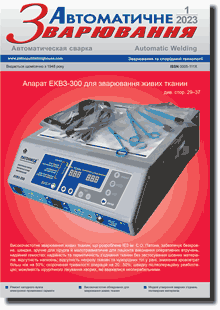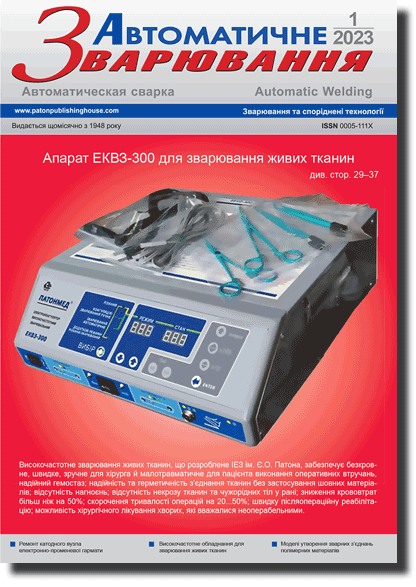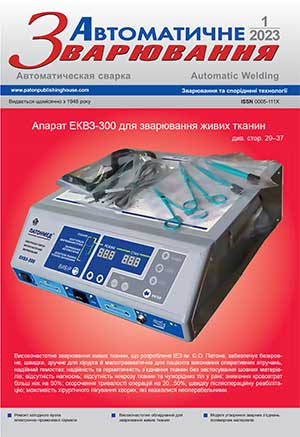Access for download PDF files for subscribers and for reviewers of scientometric bases.
Organization: Elsevier for content access(PDF files of journals released before 2024 are available for download from the website's archives))
Organization: Elsevier for content access(PDF files of journals released before 2024 are available for download from the website's archives))
| 2023 №01 (06) |
DOI of Article 10.37434/as2023.01.07 |
2023 №01 (01) |

"Avtomatychne Zvaryuvannya" (Automatic Welding), #1, 2023, pp. 47-55
Modern models of formation of polymer welded joints materials (Review)
M.G. Korab, M.V. Yurzhenko, V.L. Demchenko, Ye.P. Mamunya
E.O. Paton Electric Welding Institute of the NAS of Ukraine. 11 Kazymyr Malevych Str., 03150, Kyiv, Ukraine. E-mail: office@paton.kiev.uaThe process of welding plastics is determined as a gradual disappearance of the boundary interface between parts to be joined and the formation of a transition layer between them, whose structure is significantly different from the structure of the base polymeric material. The models of formation of welded joints of polymers existing for today are based on different physical phenomena: mutual adhesion of substrates, diffusion of macromolecules and melt rheology. The most common is the diffusion model of macromolecules reptation in the welding zone, which many researchers refer to in order to explain experimental data. Without denying the possibility of progressive diffusion of elements of the molecular chain through the fusion surface, the position that this diffusion provides the main mass transfer during the formation of joints of welded polymers is considered to be controversial. The theory of the formation of welded joints of polymers due to conformational transformations of macromolecule fragments, being developed by the Scientific School of the PWI, is more realistic. In the development of this conformational theory, the model of homogenization of the transition layer at the boundary interface of the phases during welding of polymers is proposed based on a vacation and conformation principle. 24 Ref., 12 Fig.
Keywords: polymeric materials, welding, diffusion of macromolecules, conformational transformations
Received: 02.01.2023
References
1. Nikolaev, G.A. (1978) Welding in machine-building: Handbook in 4 Vol. Moscow, Mashinostroenie [in Russian].2. Paton, B.E. (2018) Dictionary and reference book on welding and gluing of plastics. Kyiv, Naukova Dumka [in Ukrainian].
3. Komarov, G.V. (2006) Connections of parts from polymer materials. Moscow, Professiya [in Russian].
4. ISO 472:2013 Plastics - Vocabulary. Geneva.
5. Grishin, N.A., Voyutskii, S.S., Gudimov, M.M. (1957) On mechanism of welding of organic glasses. Doklady AN SSSR, 116(4), 629-632 [in Russian].
6. Voyutsii, S.S. (1960) Autohesion and adhesion of high polymers. Moscow, Rostekhizdat [in Russian].
7. Grishin, N.A., (1963) Weldability of thermoplasts. Vysokomolekulyarnye Soyedineniya, 3, 33-35.
8. Wool, R.P., O'Connor, K.M. (1981) A theory of crack healing in polymers. J. of Applied Physics, 52(10), 5953-5963. https://doi.org/10.1063/1.328526
9. Lipatov, Yu.S., Privalko, V.P. (1976) On possibility of folding of marcomolecules in amorphous polymers. Vysokomolekulyarnye Soedineniya, 18, А(5), 991-996 [in Russian].
10. Yeh, G.S.Y. (1972) A structural model for the amorphous state of polymers. Folded-chain fringed micellar grain model. J. of Macromolecular Sci., 6, 2(3), 465-468. https://doi.org/10.1080/00222347208219128
11. Wool, R.P. (1995) Polymer Interfaces: Structure and Strength. Hanser Publishers.
12. Volynsky, A.L., Bakeev, N.F. (2009) Healing of interphase surface in polymer systems. Vysokomolekulyarnye Soedineniya, series А, 51(10), 1783-1816 [in Russian]. https://doi.org/10.1134/S0965545X09100071
13. Grevell, D. (2007) Welding of plastics: Fundamentals and new developments. Int. Polymer Processing, XXII, 43-46. https://doi.org/10.3139/217.0051
14. Gennes de P. (1982) Ideas of scaling in polymer world. Moscow, Mir [in Russian].
15. Gubenko, S.I., Zhuravlev, S.I., Konovalov, N.A. (2014) On physical nature of appearance of "dead spot" type defects in resistance welding of main pipelines from ferritic-pearlitic steels. Metallofizika i Novejshie Tekhnologii, 36(5), 661-688 [in Russian]. https://doi.org/10.15407/mfint.36.05.0661
16. Zajtsev, K.I. (1973) Mechanism of joint formation in flash butt welding. Avtomatich. Svarka, 9, 29-30 [in Russian].
17. Lipatov, Yu.S. (1977) Physical chemistry of filled polymers. Moscow, Khimiya [in Russian].
18. Chalykh, A.E. (2015) Diffusion in polymer systems. Moscow, Khimiya [in Russian].
19. Komarov, G.V. (2015) Composition and properties of polymer materials affecting their weldability. Polimernye Materialy, 9, 44-48 [in Russian].
20. Grinyuk, V.D., Shadrin, A.A., Korab, G.N. (1992) Molecular mechanism of formation of thermoplastic material welded joints. Avtomatich. Svarka, 7-8, 33-36 [in Russian].
21. Galchun, A., Korab, N., Kondratenko, V. et al. (2015) Nanostructurization and thermal properties of polyethylenes' welds. Nanoscale Research Letters, 10, 138-144. https://doi.org/10.1186/s11671-015-0832-4
22. Demchenko, V., Iurzhenko, M., Shadrin, A. et al. (2017) Relaxation behavior of polyethylene welded joints. Ibid., 12, 280-285. https://doi.org/10.1186/s11671-017-2059-z
23. Iurzhenko, M. (2018) Novel theory of plastics welding and its application. In: Proc. of 10th Int. Сonf. Advanced Materials and Technologies: From Idea to Market (Ningbo, China, 24-26 October 2018).
24. Hosemann, R. (1882) Dependence of the change in the free enthalpy on the lattice number with the formation of microparacrystals. Colloid and Polymer Sci., 9, 864-870.
Advertising in this issue:
The cost of subscription/purchase order journals or individual articles
| Journal/Currency | Annual Set | 1 issue printed |
1 issue |
one article |
| TPWJ/USD | 384 $ | 32 $ | 26 $ | 13 $ |
| TPWJ/EUR | 348 € | 29 € | 24 € | 12 € |
| TPWJ/UAH | 7200 UAH | 600 UAH | 600 UAH | 280 UAH |
| AS/UAH | 1800 UAH | 300 UAH | 300 UAH | 150 UAH |
| AS/USD | 192 $ | 32 $ | 26 $ | 13 $ |
| AS/EUR | 180 € | 30 € | 25 € | 12 € |
| SEM/UAH | 1200 UAH | 300 UAH | 300 UAH | 150 UAH |
| SEM/USD | 128 $ | 32 $ | 26 $ | 13 $ |
| SEM/EUR | 120 € | 30 € | 25 € | 12 € |
| TDNK/UAH | 1200 UAH | 300 UAH | 300 UAH | 150 UAH |
| TDNK/USD | 128 $ | 32 $ | 26 $ | 13 $ |
| TDNK/EUR | 120 € | 30 € | 25 € | 15 € |
AS = «Automatic Welding» - 6 issues per year;
TPWJ = «PATON WELDING JOURNAL» - 12 issues per year;
SEM = «Electrometallurgy Today» - 4 issues per year;
TDNK = «Technical Diagnostics and Non-Destructive Testing» - 4 issues per year.









